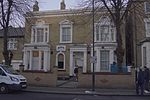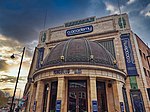Villa Road

Villa Road is a street in Angell Town in the Borough of Lambeth, south London. Rows of terraced houses, built on both sides of the street in the Victorian era, were scheduled to be demolished in the late 1960s as part of a development plan. From 1973 onwards, houses were squatted and an alternative community was established, containing anarchists, British Black Panthers, feminists, Marxists, primal screamers and single mothers. Lambeth Council applied for possession orders for most of the buildings on the street in June 1976 and the squatters built barricades to resist eviction. After prolonged negotiations the council decided to legalize the occupation in 1978, but only after demolishing the southern side of the street. In 2006, the former squatters were profiled in the documentary film "Property is Theft" as part of the BBC series Lefties.
Excerpt from the Wikipedia article Villa Road (License: CC BY-SA 3.0, Authors, Images).Villa Road
Villa Road, London Loughborough Junction (London Borough of Lambeth)
Geographical coordinates (GPS) Address Nearby Places Show on map
Geographical coordinates (GPS)
| Latitude | Longitude |
|---|---|
| N 51.4673 ° | E -0.1113 ° |
Address
Villa Road
Villa Road
SW9 7YA London, Loughborough Junction (London Borough of Lambeth)
England, United Kingdom
Open on Google Maps







